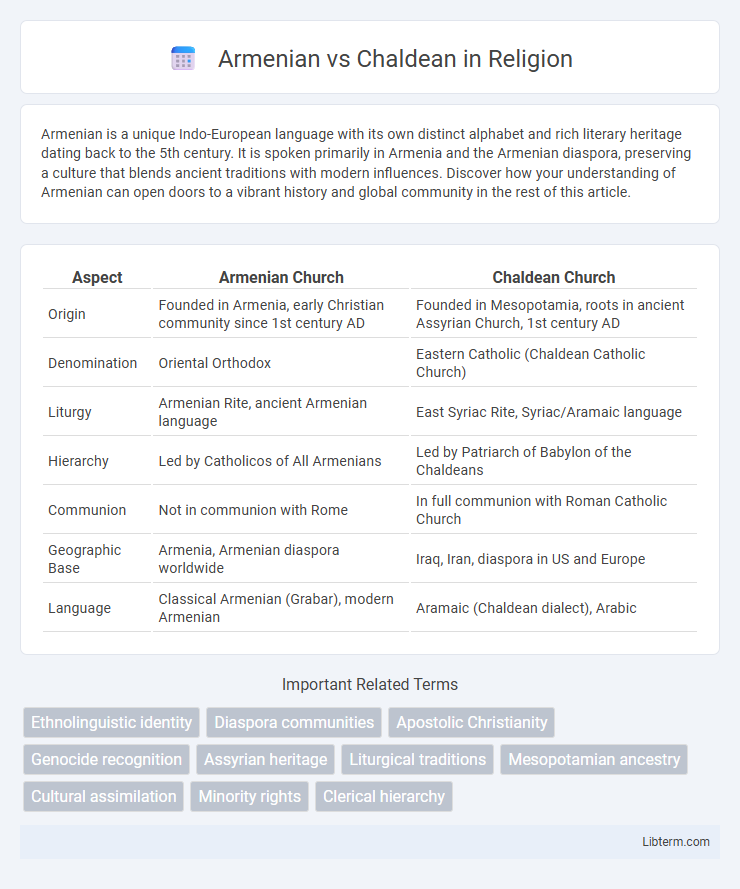Armenian is a unique Indo-European language with its own distinct alphabet and rich literary heritage dating back to the 5th century. It is spoken primarily in Armenia and the Armenian diaspora, preserving a culture that blends ancient traditions with modern influences. Discover how your understanding of Armenian can open doors to a vibrant history and global community in the rest of this article.
Table of Comparison
| Aspect | Armenian Church | Chaldean Church |
|---|---|---|
| Origin | Founded in Armenia, early Christian community since 1st century AD | Founded in Mesopotamia, roots in ancient Assyrian Church, 1st century AD |
| Denomination | Oriental Orthodox | Eastern Catholic (Chaldean Catholic Church) |
| Liturgy | Armenian Rite, ancient Armenian language | East Syriac Rite, Syriac/Aramaic language |
| Hierarchy | Led by Catholicos of All Armenians | Led by Patriarch of Babylon of the Chaldeans |
| Communion | Not in communion with Rome | In full communion with Roman Catholic Church |
| Geographic Base | Armenia, Armenian diaspora worldwide | Iraq, Iran, diaspora in US and Europe |
| Language | Classical Armenian (Grabar), modern Armenian | Aramaic (Chaldean dialect), Arabic |
Historical Origins: Armenians vs Chaldeans
Armenians trace their origins to the ancient kingdom of Urartu and Indo-European settlers in the Armenian Highlands, with a history dating back over 3,000 years. Chaldeans, originating in southern Mesopotamia, are descendants of ancient Semitic peoples who established the Chaldean dynasty in Babylon during the first millennium BCE. Both groups have preserved distinct linguistic and cultural identities through millennia despite geopolitical changes in the Near East.
Geographic Distribution and Diaspora
Armenians predominantly inhabit the South Caucasus region, primarily within Armenia, with significant diaspora communities in Russia, the United States, France, and the Middle East. Chaldeans, an ethnic Assyrian group, are mainly concentrated in northern Iraq, particularly in the Nineveh Plains, with diaspora populations in the United States, Australia, and Sweden. Both groups maintain strong cultural identities through churches and community organizations across their widespread diasporas.
Language and Linguistic Differences
Armenian, an Indo-European language, features its unique alphabet and distinct phonetic system with two primary dialects, Eastern and Western Armenian, whereas Chaldean, a Semitic language, employs the Syriac script and belongs to the Aramaic subgroup. Armenian grammar shows a complex system of verb conjugations and noun declensions, contrasting with Chaldean's root-based morphology common in Semitic languages. Linguistically, Armenian has evolved independently with significant influences from Iranian and Greek, while Chaldean maintains closer ties to ancient Mesopotamian languages and exhibits characteristics typical of Neo-Aramaic dialects.
Religious Beliefs and Traditions
Armenians primarily follow the Armenian Apostolic Church, one of the oldest Christian denominations, with unique liturgical practices rooted in early Christianity and the use of the Armenian language in worship. Chaldeans belong to the Chaldean Catholic Church, an Eastern Catholic Church in full communion with the Roman Catholic Church, preserving ancient East Syriac liturgy and traditions. Both communities maintain distinctive religious festivals, such as Armenian Vardavar and Chaldean Mar Mattai feast, reflecting their rich heritage and cultural identity.
Cultural Practices and Celebrations
Armenian cultural practices center around the Armenian Apostolic Church, with celebrations such as Vardavar, involving water festivals, and Armenian Christmas on January 6th marking the Epiphany. Chaldean traditions are deeply linked to the Chaldean Catholic Church, with major celebrations like Kha b-Nisan (Assyrian New Year) and Easter emphasizing communal feasts and religious rites. Both cultures emphasize family gatherings and preserving ancient customs, but differ in linguistic heritage and specific religious calendars.
Cuisine and Culinary Distinctions
Armenian cuisine features dishes like khorovats (grilled meats), lavash bread, and dolma, characterized by rich herbs, garlic, and a balance of spices reflecting the Mediterranean and Middle Eastern influences. Chaldean cuisine emphasizes hearty stews such as pacha and kubba, utilizing ingredients like rice, lamb, and bulgur with distinct flavor profiles shaped by Assyrian and Mesopotamian culinary traditions. Both cuisines highlight the use of fresh vegetables, legumes, and aromatic spices, yet Armenian food leans toward tangy and herbaceous flavors, while Chaldean dishes prioritize robust, savory, and slow-cooked tastes.
Contributions to Art, Music, and Literature
Armenians have significantly influenced global art through intricate khachkars, unique manuscript illumination, and epic poetry like "Daredevils of Sassoun," while their contributions to music include the duduk and Gregorian chants. Chaldeans have enriched literary traditions with ancient Mesopotamian texts and Christian theological works, alongside distinctive music featuring traditional instruments such as the zurna and darbuka. Both cultures have preserved rich heritages that intertwine historical narratives with artistic innovation across centuries.
Social Structure and Community Life
Armenian social structure is traditionally organized around tight-knit family units and strong church influence, particularly the Armenian Apostolic Church, which plays a central role in community life and cultural preservation. In contrast, Chaldean communities emphasize clan and tribal affiliations alongside the Chaldean Catholic Church as a pivotal institution fostering social cohesion and identity. Both groups maintain rich communal traditions, with Armenians often hosting cultural events centered on historical resilience, while Chaldeans prioritize religious festivals and social gatherings reinforcing their collective heritage.
Experiences of Migration and Assimilation
Armenian migration narratives are often shaped by the Armenian Genocide, leading to widespread diaspora communities emphasizing preservation of language and Christian heritage. Chaldean migration primarily stems from conflict in Iraq, with a strong focus on maintaining Chaldean Catholic identity amid assimilation pressures in Western countries. Both groups exhibit resilience through cultural retention and adaptation, yet differ in religious institutions and historical trauma influencing their assimilation strategies.
Modern Identity and Future Challenges
Armenian and Chaldean communities maintain distinct modern identities shaped by their unique linguistic, religious, and cultural heritages, with Armenians predominantly speaking Western and Eastern Armenian dialects and practicing Armenian Apostolic Christianity, while Chaldeans primarily speak Neo-Aramaic and follow the Chaldean Catholic Church. Both groups face future challenges including preserving their languages amid diaspora assimilation, combating cultural erosion, and addressing political representation in Middle Eastern and global contexts. Efforts to modernize education and digital presence play a crucial role in sustaining their heritage and fostering community resilience.
Armenian Infographic

 libterm.com
libterm.com